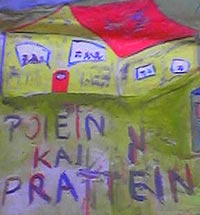Networking sustainable, creative Communities by Jesse Marsh
What I will talk about?
•Terminology
What do we mean by technology, networking, sustainability, creativity and communities?
•Projects
What we have been doing in the context of selected EU Projects to build networks of creative, sustainable communities.
•Reflections
Some ideas on the new cultural topography of Europe and its implications
Technology
1.a The application of science, especially to industrial or commercial objectives
1.b The scientific method and material used to achieve a commercial or industrial objective
2. Anthropology The body of knowledge available to a civilization that is of use in fashioning implements, practicing manual arts and skills, and extracting or collecting materials.
Networking
•Availability of technologies to help people communicate is not the problem
•Two key factors:
The desire and/or need to communicate
Something in common, something special
Economies of scale
Need to collaborate
The ability to costruct a culture of tele-communication
Access to infrastructures
Common use of basic tools (e.g. Word, Excel)
Openness to confrontation, negotiation, barter…
•Building networks implies using technical
Sustainable
Equity Futurity
Participation
Ecology
Creative
Economy Social Environmental Cultural
- critical mass
- diversity
- accessibility
- safety and security
- identity and distinctiveness
- innovativeness
- linkage and synergy
- competiveness
- organisational capacity
Communities
•Two main definitions
A group of people living in the same place
A group of people with common interests
•Virtual and Real communities
Networking reinforces face-to-face
Networking allows for complex compositions of “belonging”
•Issues of representation
Crisis of representation of traditional institutions
Networks search for means of self-governance
Projects
•AGORA: A Network of Networks for Small Businesses
DG XIII, Telematics Applications Program, Support Actions
•LORE: Local and Regional Observatory Planning Observatory Network
DG XVI, Art. 10, TERRA Program
•ISIAS: Information Society Impact Assessment for Sustainability
DG III/XIII, Information Society Project Office
•ASIS: Alliance for a Sustainable Information Society
DG XIII, Advanced Communications Technologies and Services Programme
AGORA
•Telematics Applications Program: Support Actions to involve SMEs as users
•AGORA Project: Developing a self-sustainable telematics service for intermediary organisations supporting small businesses
42 Partners in 12 Member States, 552 mm in 3 years
24 Regional Support Units, each of which manages a local network of One-Stop Shops
Networking based on usage of common GroupWare system
Flexible Portal Engine to develop regional teleservices
Transaction system for infra-network barter and exchange
LORE
•TERRA: Spatial planning innovations in environmentally vulnerable areas
•LORE Project: Network of Local Observatories for implementation of sustainability objectives
Ikaria (GR), Eastern Pelion (GR), Messara (GR), Alcamo (IT), Ragusa (IT)
Experiments in linking sustainable planning objectives to local development initiatives
Development of a trans-European observatory network using FirstClass
Local observatories linked to GIS systems and AGORA network
ISIAS
•ISPO task: Awareness-raising, involvement of local actors in shaping the Information Society
•ISIAS Project: Integrating IS and SD in regional development policies
Kortrijk (BE), Ganderkesee (DE), Helsinki (FI, Highlands & Islands (UK), Golfo di Castellammare (IT)
Local IS Workgroups develop Sustainable IS scenarios
ISIAS partners build regional simulation models to evaluate options
Comparative analysis of regional scenarios feeds into a Common Impact Assessment framework
ASIS
•Building on the ACTS GAD Chain
Investigating the potential contribution of advanced communications technologies to sustainability
•ASIS: Building a trans-European Alliance committed to IS-SD action
Main Alliance actors: Industry, regional development, NGOs
Concertation tools: Statement of Intent, Concerted Action Plans
Actors define their own targets, commitments, benchmarks
Work Group 1: Sustainable Communities
•Statement of Intent
Signed by over 50 organisations
•Action Groups
Sustainable Communities
Dematerialisation of Industrial and Business Processes
Social Inclusion
Mobility and Transport
Homes and Workplaces of the Future
Electronic Commerce
Life-long Learning and Education
Health Care
Climate Change (Post-Kyoto)
Eco-balance of the Information Society
•“Sustainable Communities in the Information Society: New Models for Providing Services to Citizens”
Palermo Workshop, 5-6 July
Presentation of ASIS and the ISIAS Common IA Framework
Local Experiences
City, municipal companies, Telecom Italia, Universities...
European Experiences
Impact assessment, management of negotiation processes, geo-referencing information, evaluation of public programs, small business support services, etc.
Development of a Proposal for the V Framework Program
Information Society Technologies Action Line I.1.1
Reflections
•Networking requires a proper mix between technical and human infrastructures
•3 Key factors
Clear and appropriate network architecture
Network animation at all levels
Capacity of self-governance
•Networking reveals new patterns of culture and community
•Networking helps communities be creative
•Culture is a key determinant in defining the relation between creativity and innovation
Key Trends
•INFORMATION ® COMMUNICATION
•PRODUCT ® PROCESS
•SECTORIAL ® INTEGRATED
•HOMOGENEITY ® MOLTEPLICITY
•LINEAR ® CYCLICAL
•COORDINATION ® ANIMATION
•EVOLUTION ® RUPTURE
« Palermo: the City of Opportunities - Industrial Heritage Network Plan by Maurizio Carta | Workshop 2.2: Development and Technical Infrastructures »
